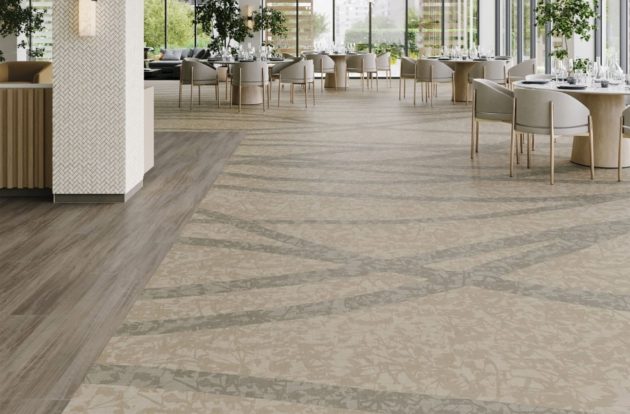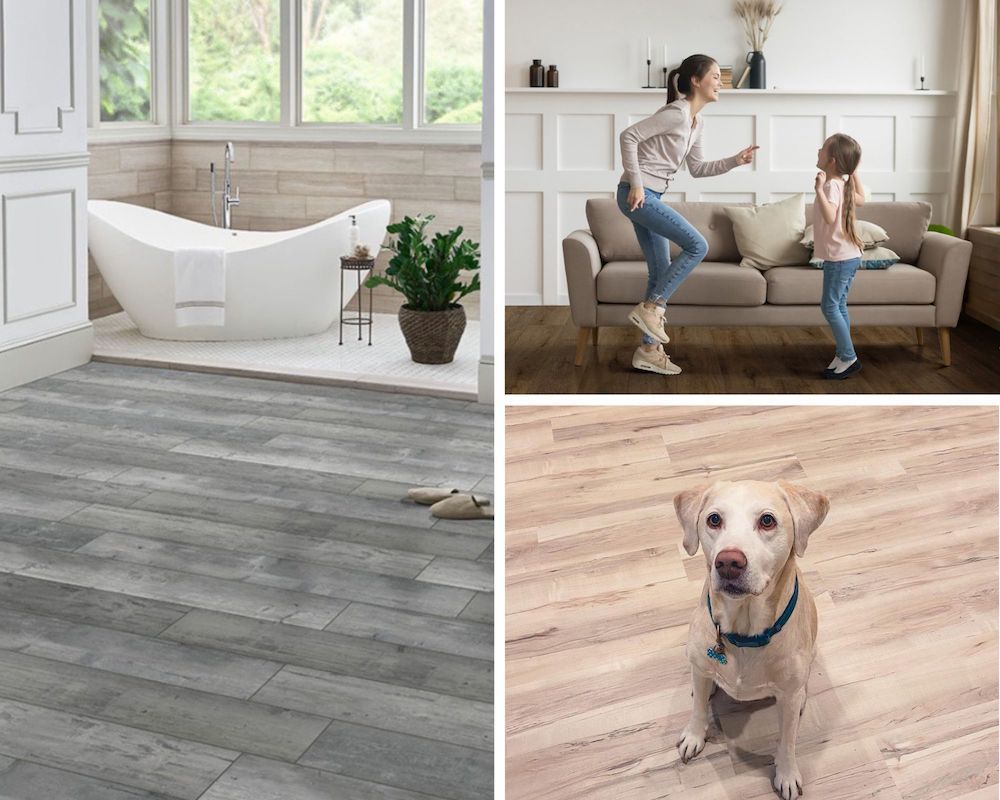To get waves out of vinyl flooring, use a hairdryer and a towel for heat and pressure respectively. Vinyl flooring is a popular choice due to its durability and easy maintenance.
However, over time, waves or bumps may appear on the surface, which can be unsightly and pose a tripping hazard. Fortunately, there is a simple solution to this problem. By applying heat from a hairdryer to the affected area and immediately placing a towel over it to provide pressure, you can effectively flatten out the waves.
This method allows the vinyl to become more pliable and reshape itself, providing a smooth and even floor surface once again. We will explore the step-by-step process of getting waves out of vinyl flooring using these two basic household items.
Assessing The Condition Of The Vinyl Flooring
Inspecting for visible waves or bulges is an important step in determining the condition of vinyl flooring. These waves can indicate underlying issues that need to be addressed.
| Cause of Waves | Description |
|---|---|
| Excessive moisture | Excess moisture can cause vinyl flooring to become warped and form waves. It is important to identify the source of the moisture and address it before attempting to remove the waves. |
| Subfloor issues | Uneven or damaged subfloors can also lead to the formation of waves in vinyl flooring. Inspecting the subfloor is crucial in determining whether it needs repairs or replacement. |
| Incorrect installation | Improper installation techniques can result in waves and bulges in vinyl flooring. Identifying any installation errors will help determine the necessary steps to fix the flooring. |
Addressing these issues before attempting to remove the waves is imperative to ensure the longevity and performance of the vinyl flooring. By identifying the cause of the waves and taking appropriate action, homeowners can enjoy a smooth and flawless vinyl floor.
Preparing The Necessary Tools And Materials
| Utility knife |
| Floor leveling compound |
| Pry bar |
| Hammer |
| Nails |
| Repair adhesive |
| Plywood |
| Screws |
| Self-leveling compound |
| Seam sealer |
Fixing Minor Waves And Bulges
Fixing minor waves and bulges on vinyl flooring is a relatively simple process that can be done by following a few steps. First, remove the baseboard or quarter round to access the affected area. This can be done by gently prying it away from the wall. Next, lift the vinyl planks that are causing the waves or bulges. Use a putty knife or similar tool to carefully lift the edges of the planks. Once the planks are lifted, apply a floor leveling compound to the subfloor. Spread the compound evenly over the area, making sure to fill in any low spots. Smooth the compound with a trowel or another tool, ensuring that it is level with the surrounding floor. After the compound has dried, reattach the vinyl planks by pressing them back down into place. Finally, reattach the baseboard or quarter round to complete the repair.
Addressing Major Waves And Bulges
To address major waves and bulges in vinyl flooring, the first step is to detach the damaged vinyl flooring. Inspect the subfloor for any issues that may be causing the waves. Repairing the subfloor may be necessary to create a level surface. This can involve replacing damaged plywood or securing loose boards. It’s crucial to ensure that the subfloor is level before proceeding. Once the subfloor is in good condition, the vinyl flooring can be reinstalled. Taking these steps will help you get rid of waves and bulges in your vinyl flooring, resulting in a smooth and visually appealing surface.
Installing A New Underlayment
To get waves out of vinyl flooring, it’s important to start by installing a new underlayment. This involves removing the existing underlayment and preparing the subfloor for the installation of the new underlayment.
Removing the existing underlayment should be done carefully to avoid damaging the subfloor. Once the old underlayment is cleared, the subfloor needs to be cleaned and repaired to ensure a smooth surface.
Next, the new underlayment is installed. This can vary depending on the type of underlayment being used, whether it’s plywood or another material. It’s important to follow manufacturer instructions and use the appropriate tools and techniques for installation.
Finally, the underlayment needs to be secured properly. This may involve nailing, stapling, or gluing the underlayment to the subfloor to ensure it stays in place and provides a stable base for the vinyl flooring.

Reinstalling The Vinyl Flooring
Preparing the vinyl flooring for reinstallation involves a few simple steps. First, check for any areas where the seams may have come apart or where the flooring has become loose. If you notice any issues, it’s important to apply seam sealer to prevent further damage. Once the necessary repairs have been made, lay the vinyl flooring back in place, starting from one corner and working your way across the room. Make sure to align the edges and smooth out any wrinkles or bubbles as you go. To secure the flooring properly, use a flooring adhesive or double-sided tape, following the manufacturer’s instructions. Finally, reattach the baseboard or quarter round to give the flooring a finished look. Take care to match the trim with the existing decor for a seamless transition.
Preventive Measures To Avoid Future Waves In Vinyl Flooring
Preventive Measures to Avoid Future Waves in Vinyl Flooring
Ensuring proper subfloor preparation is the key to preventing waves in vinyl flooring. Before installation, the subfloor should be clean, level, dry, and free of any debris or imperfections. A moisture barrier is essential to protect the vinyl flooring from moisture-related issues. It prevents moisture from seeping through the subfloor and causing damage.
Using the correct adhesive is crucial for ensuring a secure and long-lasting bond. It is essential to choose an adhesive that is suitable for vinyl flooring and follow the manufacturer’s instructions for application. Overexposure to moisture can lead to waves in vinyl flooring. Avoid installing vinyl flooring in areas prone to excessive moisture, such as bathrooms or basements without proper waterproofing measures.
| Preventive Measures | Description |
|---|---|
| Proper subfloor preparation | Ensure the subfloor is clean, level, and free of imperfections. |
| Moisture barrier | Install a moisture barrier to protect against moisture-related damage. |
| Correct adhesive | Use the appropriate adhesive for vinyl flooring. |
| Avoid overexposure to moisture | Avoid installing vinyl flooring in moisture-prone areas without proper waterproofing. |
Frequently Asked Questions Of How To Get Waves Out Of Vinyl Flooring
How Do You Fix Vinyl Floor Ripples?
To fix vinyl floor ripples, first, identify the cause, which could be moisture, improper adhesive, or uneven subfloor. If it’s moisture, dry the area and replace damaged vinyl. For adhesive issues, reapply adhesive and press down. For an uneven subfloor, level it before reinstalling the vinyl.
Why Is My Vinyl Floor Wavy?
Vinyl floors can become wavy due to poor installation or moisture issues. Incorrect subfloor preparation or inadequate adhesive can cause the vinyl to warp and create waves. Moisture from underneath or improper acclimatization can also lead to warping. Ensuring proper installation and addressing any moisture problems can help prevent this issue.
What Causes Vinyl Flooring To Ripple?
Poor installation, moisture, or temperature changes can cause vinyl flooring to ripple. Incorrectly aligning and securing the flooring, or exposing it to excessive moisture or extreme temperature fluctuations, may result in the material buckling or warping.
Will Bubbles In Vinyl Flooring Go Away?
Bubbles in vinyl flooring may disappear over time with proper installation and floor preparation.
Conclusion
To conclude, getting rid of waves in vinyl flooring is not as daunting as it may seem. By following the steps mentioned in this blog post, you can easily fix the problem and restore your flooring to its original condition.
Remember to inspect the subfloor, use a heat gun or hairdryer, and apply pressure to flatten the waves. Regular cleaning and maintenance will also help prevent future wave formation. With these simple techniques, you can enjoy a smooth and beautiful vinyl flooring for years to come.




